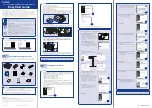
The rear of the radio has the required warning label and serial number. Write the serial number down
someplace safe so that if the radio is stolen it can be entered into police databases. This will help return the
radio to you if it is recovered by the police.
Also included in the box is the USB cable, telescopic antenna, a disk with the owner’s manual and some
demo applications. The PSR-600 also comes with a listing of the preloaded files in the V-Scanner
memories.
Comparison to the BCD996T and XT
You can’t talk about this radio without discussing the competition from Uniden Bearcat. The Uniden
BCD996XT is the direct competition to the PSR600. Many of the comparisons are pretty much the same
amongst all of the GRE and Uniden scanners.
On the Uniden one uses modifier keys and a multi-function knob for programming while the GRE uses the
keypad much more intensely. The Uniden takes more effort to operate the radio because with fewer keys
you have to remember what many consider to be difficult key combinations. The GRE has more keys so
it’s easier to operate.
While both radios use forms of dynamic memory architecture, they go about it differently. The Uniden is a
bit more conventional in that you create Systems instead of Banks and turn them on or off while the GRE
has you enter the objects once and let’s you create multiple scan lists (unfortunately only up to 20) to
choose the items you want to scan.
The Uniden has many features that some might want while others may not need. These include the ability
to connect to a GPS unit and use that to control what you want to listen to (a fantastic feature for mobile
use that is described elsewhere on Scanner Master’s site). In addition, the Uniden has Fire Tone Out, the
ability to use Remote Heads and other fun to use and explore features.
The GRE is well regarded as having better audio, especially on digital signals. While the Uniden XT series
has improved the digital decoding over its predecessors, the PSR600 is still superior.
I will discuss the comparison of the two radios in more detail later in this article.
How many Channels
The first question many people ask about a scanner is: How many channels can you program? The answer
with the PSR600 is “Well, it depends.” Depends on what? Well, it depends on how you define channels and
how you program your radio. The PSR-600 uses GRE’s Object Oriented User Interface (OOUI)
programming method. While older radios use defined channels and banks, the PSR-600’s OOUI has the
user enter channels into memory along with trunked system parameters (including Talkgroups) and various
types of searches. The user then creates up to 20 Scan Lists that point to the various channels, talkgroups
and searches. This allows you to select what you want to listen to at the time. Scan Lists can include any of
the programmed operations, and any of the programmed operations may be included in multiple Scan Lists.
This is somewhat similar to Uniden’s Quick Key system of enabling different sets of channels, search
ranges, service searches, etc.
GRE advertises the radio as “Over 1800” Scannable Objects. This basically means that you can scan
around 1800 objects at a time. This number can be affected by the type of object you program and how you
use Text labels, and other parameters. With the 21 available V-Scanners this works out to over 37,000
available memories. Will you be able to program 37,000 channels? Probably not, but you might if you try
hard enough!
If you want to see how much memory you have used or have left you can press “0” twice during the start-
up screen.
V-Scanners



































